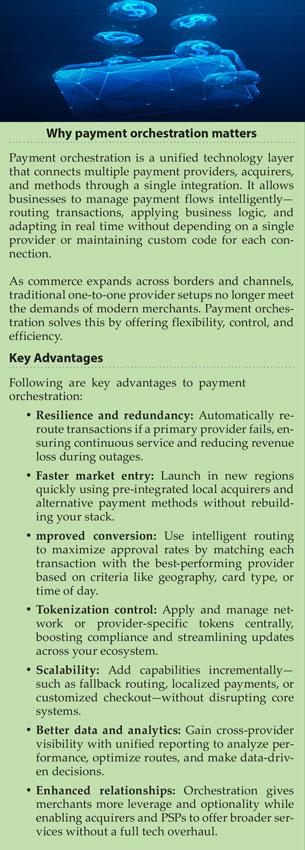The Green Sheet Online Edition
May 26, 2025 • 25:05:02
Why early bets on payment orchestration are paying off

It used to be that setting up payments was relatively straightforward. Pick a provider, plug in your device and you were good to go. That model no longer holds. As commerce has expanded across markets and channels, the demands on payment systems have increased, and so has the pressure to make them more adaptable.
That shift in expectations is one reason payment orchestration has picked up pace. What began as a workaround for managing multiple providers has steadily built momentum, first among digital-first merchants with global reach, and now across the wider ecosystem.
Adoption is accelerating for a reason. According to Global Payments, 35 percent of businesses plan to increase investment in payment orchestration in 2025. The market is projected to grow by nearly 25 percent a year until 2030. What was once considered a tactical fix is fast becoming essential infrastructure. And for the merchants who moved first, the benefits are now clear.
The early advantage
The businesses that adopted payment orchestration early weren’t just experimenting with new tech. They had specific, recurring challenges: slow onboarding of new payment methods, poor reach across markets, a lack of resilience, and fragmented integrations that couldn’t support scale or adapt quickly to market changes.
For these digital-first merchants, payment orchestration was a way to regain control. Rather than tying themselves to one provider, they could access multiple acquirers, gateways and payment methods through a single connection. More importantly, they could steer transactions based on their own logic, unencumbered by their provider’s limitations. Those early adopters are now two steps ahead.
They’ve built payment orchestration into their operations, tested their strategies over time and developed a level of payment agility that others are only just beginning to explore. They’re rolling out new markets faster, avoiding the impact of outages and adapting more easily to regulatory shifts or scheme requirements.
Moving beyond merchant benefit
Much of the early conversation around payment orchestration focused on merchant gains, and understandably so. Many faced a build-versus-buy decision. While some attempted to create payment capabilities in-house, the effort often proved costly and difficult to scale. But the model is also proving valuable for other players in the ecosystem.
Acquirers and payment service providers (PSPs) are increasingly looking at payment orchestration not as a threat, but as a strategic tool. Some are embedding payment orchestration into their own infrastructure to help modernize legacy platforms. Others are partnering with orchestrators that offer white-label solutions that allow them to offer broader payment capabilities to their merchants, without a full rebuild.
We’re now seeing acquirers looking to use payment orchestration to combine multiple back-end systems under one interface, deliver a consistent experience across regions, and retain merchants who would otherwise seek more flexible options elsewhere. The goal isn’t to replace existing services; it’s to enhance them.
Platforms are doing the same. For ecommerce providers, payment orchestration can help unify payment flows across product lines or geographies. For travel tech platforms and software vendors, it allows them to offer enterprise-grade payment features and open up new revenue streams, without building those from scratch.
Modular adoption, real outcomes
Another reason payment orchestration is gaining momentum is its flexibility. It’s not an all-or-nothing proposition. Businesses can start with one pain point, like tokenization or routing, and scale from there.
We’ve worked with travel brands that began using payment orchestration for fallback only. After a few outages with their primary provider, they needed a way to build resilience into their stack.
Payment orchestration enabled them to route transactions through an alternative path automatically, reducing disruption without adding overhead. From there, they expanded to include routing logic, regional PSPs and new alternative payment methods. In gambling and digital goods, we’re seeing payment orchestration used in more advanced ways.
Merchants are combining centralized tokenization with localized payment connectivity and personalized checkouts to streamline both pay-in and payout flows.
Payment orchestration lets them manage these layers without hardcoding dependencies or reengineering the checkout each time they make a change.
Tokenization, in particular, has become a common entry point. With schemes pushing for greater use of network tokens, payment orchestration offers a way to apply token logic consistently across providers and token types. This gives merchants better control over compliance and conversion, while laying the groundwork for more advanced payment orchestration strategies.
For many, starting with a modular, external solution proved far more practical than maintaining bespoke infrastructure.
Supporting sustainable relationships
Payment orchestration is more than simply a technical layer. It’s also changing the way commercial relationships work.
By sitting independently, payment orchestration enables merchants to retain choice and flexibility. But it also allows payment providers to retain volume by supporting the features their customers want without needing to build everything in-house.
For acquirers, this can be a way to win business that might otherwise go to a more feature-rich competitor. For PSPs, it can be a route to offering broader capabilities through partnership.
For everyone, it’s a chance to deliver better outcomes without engaging in a race to the bottom on pricing. There is a mindset shift underway. Payment orchestration is no longer about disruption. It’s about enablement and optimization.
The payoff for moving early
While adoption is now accelerating, those who moved first have had the most time to build a competitive edge. They weren’t just patching over weak points; they were rethinking how payments should work as their businesses scaled.
That early investment is now showing results. These merchants have had the freedom to experiment, refine their routing strategies and embed orchestration into their long-term plans. They’re launching in new markets faster, handling provider outages with minimal disruption and staying ahead of compliance changes with less effort.
Rather than retrofitting payment orchestration into existing systems, they’re making it part of how they operate.
That’s given them greater control and agility in an environment that continues to change rapidly. In some cases, these early adopters are now moving away from their original orchestration partners, where there’s no longer a good fit, but they can make that move knowing exactly what they need (and don’t need) for their business as it moves forward.
As payment orchestration becomes more widespread, it’s changing expectations across the payments landscape. What was once seen as a fringe innovation is now something merchants increasingly expect from their providers. And what used to be considered advanced is quickly becoming table stakes.
That’s why timing matters. The businesses that took the leap early are now leading the way. They’re not adapting to payment orchestration; they’re defining what comes next. 
Tom Voaden is vice president of commercial at BR-DGE. Contact him at >.
Notice to readers: These are archived articles. Contact information, links and other details may be out of date. We regret any inconvenience.





